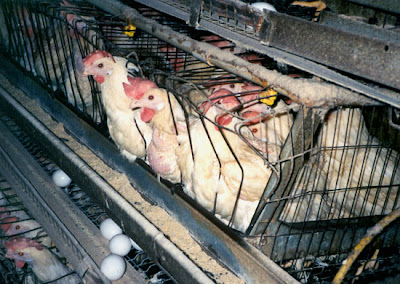First off, lets take a look at a pic of a factory farm.
 |
| Image borrowed from - http://advocacy.britannica.com/blog/advocacy/2007/05/the-difficult-lives-and-deaths-of-factory-farmed-chickens/ |
Factory chickens are given, on average, 67 square inches of space. That's approximately the size of your iPad. Sad, isn't it?
Then, let's look at your typical Cage Free, or "Free Range" chickens.
 |
| Again, image courtesy of, http://advocacy.britannica.com/blog/advocacy/2007/05/the-difficult-lives-and-deaths-of-factory-farmed-chickens/ |
My bet, is that these chickens are also Certified Organic, and/or vegetarian fed.
If you visit this link, you will see a glimpse of the sadness these birds live in - http://www.upc-online.org/freerange.html
While you may think you are doing a good thing by buying free range or certified organic, the truth is, it's no better than buying factory farm. There is just as much over crowding and inhuman treatment. When the chicks hatch at an egg farm, the roosters are often thrown away. Even while still alive. The beaks are trimmed off the hens so they can't peck each other. Which often happens when they are overcrowded and aggravated with each other.
This past spring, there was a local certified organic farm selling off some of their year old egg hens for $1 a piece. They were advertised as stew hens. Meaning they were too old to be plump and juicy, they had passed their egg laying prime, and wouldn't roast up well, but would be good for making stew or broth. After the first year of laying, a hen's output is reduced to only 80%, and each year after that it will continue to decline another 20%. For us home farmers, it's not that big of a deal. For factory farms where eggs are their livelihood, it adds up, so they get rid of them.
So, a few friends and I decided to snag a few of these Certified Organic stew hens and take them to the Amish to be butchered. If you look closely at the picture just above, you will notice that these chickens are missing a lot of feathers. That's exactly how the chickens looked that we picked up. I was appalled! They were so skinny and scraggly looking! There was zero meat on these birds! As was apparent upon pick up from the Amish. I was sincerely embarrassed to have even taken these birds to butcher.
That was my first hands on experience with the myth that Certified Organic somehow meant a better chicken. Next, is the myth that vegetarian fed hens are somehow more superior. Which, they are not. What that really means, is that the chickens NEVER get a chance to live like real chickens and forage for their own food. Chickens are birds. What do birds eat? Lots of things! Leaves, sprouts, greens, grains, etc. BUT! They also eat bugs, worms, mice, snakes, pretty much anything they can find. They LOVE to scratch through a compost pile and find maggots or larvae.
Real chickens are not vegetarian, my friends. Real chickens eat meat. So the next time you see these special key words:
Free Range
Cage Free
Certified Organic
Vegetarian Fed
Remember what you've learned here.
All these chickens are not getting the kind of nutrition needed for a high quality product. Just like when humans are missing certain nutritional supplements, we don't feel our best and can not perform our best. Well, neither can chickens. If you want a chicken to produce quality meat and eggs, it has to live a life the way God intended them to!
Not depressed, stuck inside breathing their own dust and feces, and expected to perform like a robot.
I admit, allowing true free ranging does open up the possibility of dangers from vermin. We've lost a few. But so has the factory farm down the road. It goes with the territory. At least I have happy chickens living the life they are supposed to, and they are loved.
So here's my little plea to you. Buy from a local farmer or family instead of at the grocery store. Stop supporting big businesses practicing inhumanely.
That is all.









